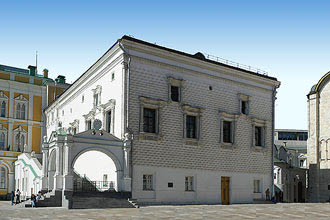 |
 Construction of the Faceted Chamber began in 1487. Italian architect Marco Ruffo began construction of the throne room in Ivan III's palace, and the work was finished by his countryman Pietro Antonio Solari. This brick building is made up of a single-pillared chamber atop a very high ground floor. Despite its minimal support, the main chamber covers an area of about 500 square meters. The southern end of the chamber joins the famous Red Porch, where Russia's rulers traditionally appeared before their people. This "Red" porch, carved from white stone, earned its name not from its color, but because the word "krasnyi", which in modern Russian means "red", once had the meaning of "beautiful". In 1930 the porch was removed, but it was returned again in 1994. Thus the Chamber was restored to its original appearance. The Chamber itself was given the epithet 'faceted' thanks to the main facade, which looks out onto Cathedral Square. The technique known as "brilliantovii rust" was used in its decoration: Each facing block of white stone was dressed with four facets. This particular workmanship is typical of the architecture of the Renaissance era.
Construction of the Faceted Chamber began in 1487. Italian architect Marco Ruffo began construction of the throne room in Ivan III's palace, and the work was finished by his countryman Pietro Antonio Solari. This brick building is made up of a single-pillared chamber atop a very high ground floor. Despite its minimal support, the main chamber covers an area of about 500 square meters. The southern end of the chamber joins the famous Red Porch, where Russia's rulers traditionally appeared before their people. This "Red" porch, carved from white stone, earned its name not from its color, but because the word "krasnyi", which in modern Russian means "red", once had the meaning of "beautiful". In 1930 the porch was removed, but it was returned again in 1994. Thus the Chamber was restored to its original appearance. The Chamber itself was given the epithet 'faceted' thanks to the main facade, which looks out onto Cathedral Square. The technique known as "brilliantovii rust" was used in its decoration: Each facing block of white stone was dressed with four facets. This particular workmanship is typical of the architecture of the Renaissance era.
The baroque decorations which are visible around the windows of the building appeared much later, at the end of the 17th century.
The interior walls and vaults of the chamber are covered with murals painted by Palekh craftsmen between 1838 and 1849. The frescoes were copied from the works of 17th century craftsmen. For many centuries the Faceted Chamber has witnessed the crucial events of Russia's history. In 1552, Ivan the Terrible celebrated the subjugation of Kazan here, and right within these walls in 1653 the Muscovite Land Assembly made the decision to unite Russia and the Ukraine. Peter the Great marked his victory over the Swedes here in 1709, and in our own era Mikhail Gorbachev used the chamber to entertain Ronald Reagan and Margaret Thatcher in the tumultuous years of perestroika. Nowadays the Faceted Chamber is used as the reception hall of the President's residence.
|
 |

 Construction of the Faceted Chamber began in 1487. Italian architect Marco Ruffo began construction of the throne room in Ivan III's palace, and the work was finished by his countryman Pietro Antonio Solari. This brick building is made up of a single-pillared chamber atop a very high ground floor. Despite its minimal support, the main chamber covers an area of about 500 square meters. The southern end of the chamber joins the famous Red Porch, where Russia's rulers traditionally appeared before their people. This "Red" porch, carved from white stone, earned its name not from its color, but because the word "krasnyi", which in modern Russian means "red", once had the meaning of "beautiful". In 1930 the porch was removed, but it was returned again in 1994. Thus the Chamber was restored to its original appearance. The Chamber itself was given the epithet 'faceted' thanks to the main facade, which looks out onto Cathedral Square. The technique known as "brilliantovii rust" was used in its decoration: Each facing block of white stone was dressed with four facets. This particular workmanship is typical of the architecture of the Renaissance era.
Construction of the Faceted Chamber began in 1487. Italian architect Marco Ruffo began construction of the throne room in Ivan III's palace, and the work was finished by his countryman Pietro Antonio Solari. This brick building is made up of a single-pillared chamber atop a very high ground floor. Despite its minimal support, the main chamber covers an area of about 500 square meters. The southern end of the chamber joins the famous Red Porch, where Russia's rulers traditionally appeared before their people. This "Red" porch, carved from white stone, earned its name not from its color, but because the word "krasnyi", which in modern Russian means "red", once had the meaning of "beautiful". In 1930 the porch was removed, but it was returned again in 1994. Thus the Chamber was restored to its original appearance. The Chamber itself was given the epithet 'faceted' thanks to the main facade, which looks out onto Cathedral Square. The technique known as "brilliantovii rust" was used in its decoration: Each facing block of white stone was dressed with four facets. This particular workmanship is typical of the architecture of the Renaissance era.